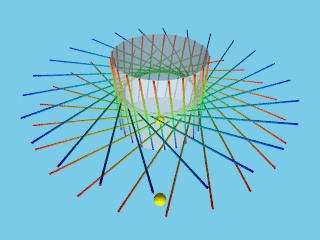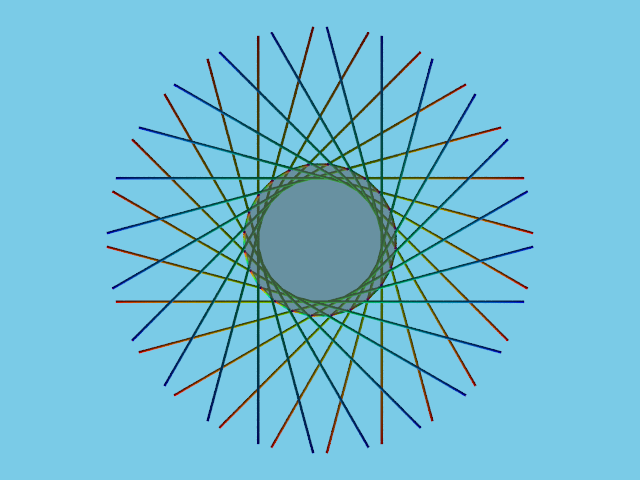I've gone through a good deal of Searl's documentation now and have been able to piece together enough of it to get an idea of what is going on, in the context of the Reciprocal System. The long and short of it is that he has been able to create a "micro-sunspot," which he calls the SEG (Searl Effect Generator). Sunspots are normally created by very high temperatures, so high that they move into the intermediate and ultra-high speed ranges. Searl was able to create a similar motion, but without the associated thermal conditions. Here is what I suspect is happening:
A basic summary of Nehru's research on sunspots gives a clue: in the sun, thermal motion exceeds 1 natural unit and moves into the intermediate speed range, moving the 1D thermal vibration into equivalent space, a 2D region, therefore becoming a 2D linear vibration. In low speed ranges, thermal vibration induces electrical ionization. In the intermediate speed range, 2D thermal vibration induces a 2D rotational vibration--magnetic ionization. This is the source of high magnetic ionization levels in the sun. When thermal motion exceeds 2 natural units, being beyond the 2-unit limit of a scalar dimension, it takes place in a 2nd scalar dimension that cannot be represented in the coordinate reference system. The magnetic effects here are described by Nehru as "thredules", a linear form of magnetism where north attracts north and south attracts south (a co-magnetic relationship).
When Searl "charges" his SEGs to get their "Searl magnetic wave" structure, he uses phased electric charge--one component is DC, the other is AC, and impulse that hits the magnetic material in the same time from different directions. The DC charge has already imposed an electric ionization (1D RV) upon the magnetic material. I suspect at this point, he uses an electric impulse to push the electric vibration into the 2nd natural unit, moving the charge into the intermediate speed range and directly creating 2D rotational vibration--magnetic ionization--and the formation of co-magnetism. The co-magnetic domains will align N-N and S-S in the material. The final AC charge applied to the material would move into the 2nd scalar dimension, since the first dimension is "full" (already at 2-unit level), creating magnetic sheaves in the material--the formation of thredules, and the generation of the Searl effect.
From the magnetic patterns he has shown in videos, he is producing a weak ultra-high speed motion. The outer sheaf runs vertically up the magnetic cylinder, and the inner sheaf streatches out like spokes of a bicycle wheel. The Searl effect shows these magnetic lines of force. Because of the rectilinear nature of the thredules (line segments, versus magnetic loops), a series of north and south poles form on opposite faces of the cylindrical magnet (top and bottom) that are not in phase--discrete poles, being the ends of the rods in the diagram. When the cylinder is rotated and a magnetic sensor placed on the side, it will bounce from pole to pole in a sinusoidal pattern, even though it is actually jumping between thredules. (Conventional magnetism will form outside the cylinder, where north and south attract, since the air is not moving in the ultra-high speed range--he does measure at a distance from the magnetic surface).
The inner sheaf of "bicycle spokes" will do the same thing, forming spokes and an outer ring of low-speed magnetism, connecting the poles together.
Looking down from the top, you basically have a micro-sunspot--the center magnet of thredules, pointed near vertical, being the umbra and the bicycle spokes being the penumbra. Evershed velocities will also occur (radial force from the center, outward), but would produce a series of cylindrical, magnetic rings about the system as the magnetic speed drops back down into the low-speed range.
Being that there is no thermal ionization involved with the effect (all electric and co-magnetic), the intermediate and ultra-high components may be a near-permanent condition, once established. To quote Nehru, "The lifetimes of these space region aggregates, that is, the times elapsed before they dissolve and give place to new aggregates, dpeends on the rate at which the heat transfer is taking place." Since thermal energy is not a major component, the lifetime will be quite long.
When the system is put in motion, a series of rollers moving about a central, larger SEG, with the magnetic interactions being in the equivalent space--everything will operate in an inverse fashion. For example, in a "normal" system, entropy and frictional losses will slow the mechanism to a stop. But in an inverse space, it will "inverse slow"--speed up on its own. And rather than heating up, it will inverse-heat and cool down (8 degree C drop in room temperature was measured in the Russian experiment). The system becomes self-accelerating. self-cooling. The lower the temperature, the longer the lifetime of the co-magnetic system, so it should operate for a very long time.
As the unit spins, it will throw off electrons. Something interesting here that has not been considered before--it was noticed that the electrons being thrown off were wavelike and superconducting--namely, paired, birotating electrons. The co-magnetic effects may provide the perfect environment for pair formation, as it is not a big jump from 2D rotational vibration to 2, 1D rotational vibration--namely, dropping out of the 2D equivalent space into normal space. Upon entering normal space (exiting the SEG), standard temperatures and pressures will degenerate the pairs, as happens in experiments, releasing the electrons into the environment to be picked up by Searl's coils for power generation.
The final effect would be a result of the ultra-high motion of the thredules. As the system accelerates, ultra-high speed motion will also increase in response to the co-magnetic interaction of the rotating components. As documented by Larson in his dissertations on Pulsars, ultra-high speed motion acts as inverse gravity--it will move an object to the location it was in, prior to the effect of gravity (UOM, p 213). This is NOT "anti-gravity", but a cancellation of the gravitational motion produced by mass. In other words, the SEG will want to fall upwards, in the opposite direction of gravity. First the Earth's gravity, then the sun, then the solar system,... right on out. Searl used this effect to build his IGV (Inverse Gravity Vehicle) back in 1968. (I have found it curious he calls it "inverse gravity", not "anti-gravity.")
This is a GIF animation of a SEG rotating. The bouncing, yellow balls show the path of conventionally measured magnetic flux--the "Searl Magnetic Wave" that is unique to his devices.

- SEG-Wave-Anim.gif (190.2 KiB) Viewed 20026 times
Top view of SEG (bicycle spokes):

- SEG-top.png (104.34 KiB) Viewed 20026 times
Every dogma has its day...
